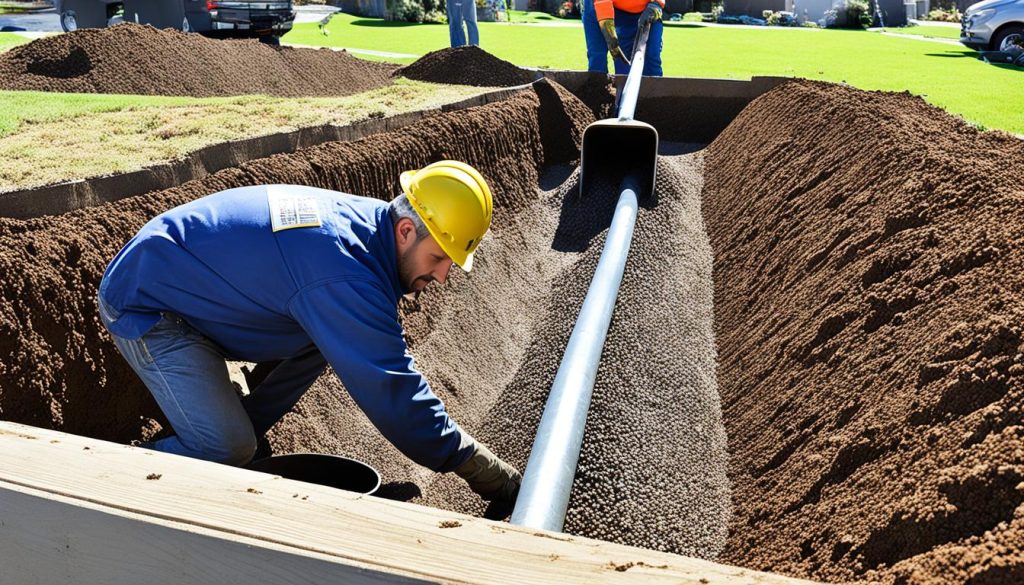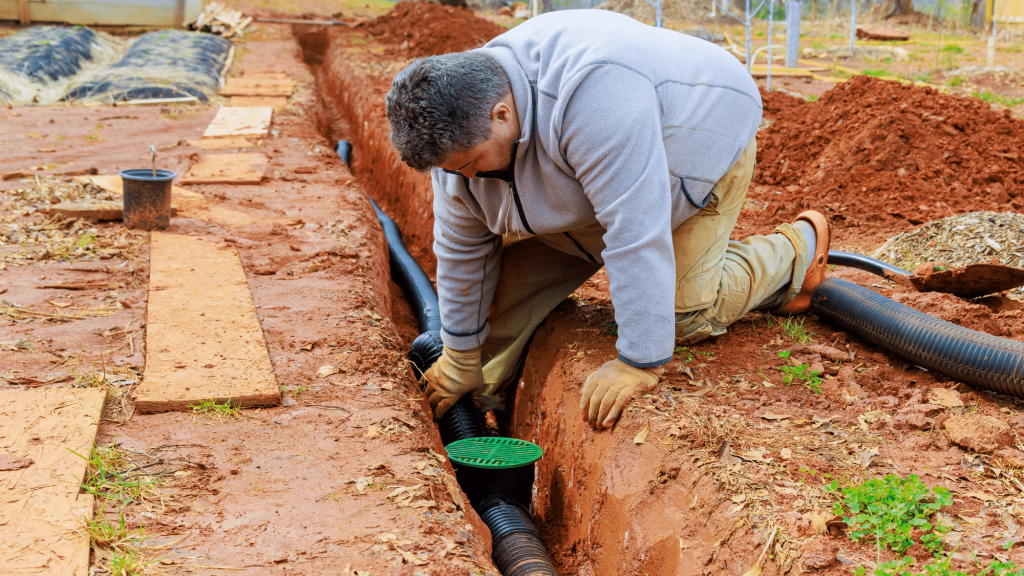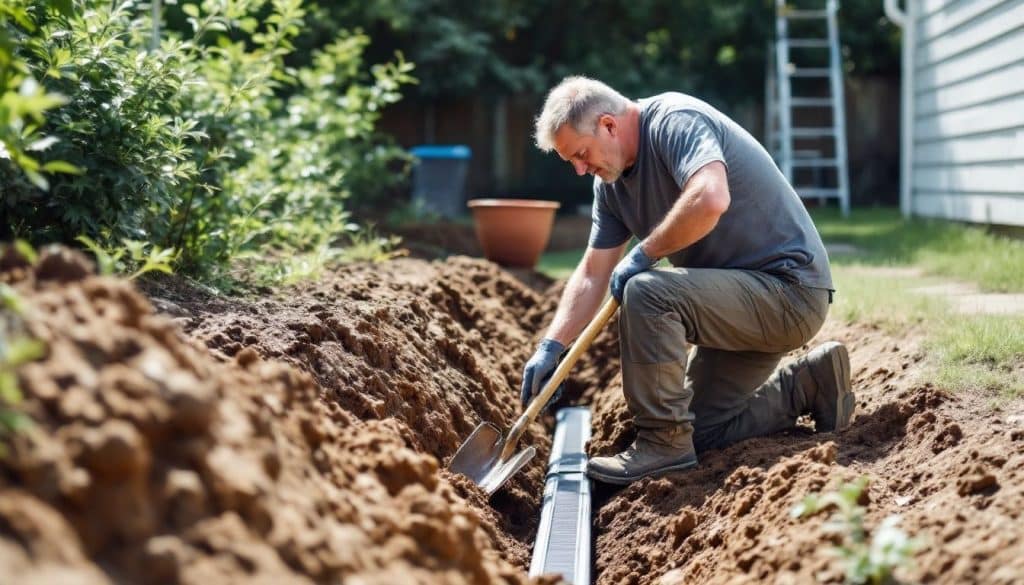Table of Contents
Water everywhere, but not a drop where it should be? If you’re wrestling with soggy lawns, basement leaks, or standing water in your yard, know that you’re in good company. These pesky drainage issues can quickly turn a stunning yard into an unwelcome mess.
Ever wondered about What is the Best Time to Install a French drain? Like many of us who’ve grappled with these challenges, understanding that installing a French drain might just be the fix we need was a game-changer. What’s more intriguing is discovering just how critical timing is to its success and durability.
Our guide aims to shine a light on the perfect moment for action—not only addressing your current woes but steering clear of future headaches too. Stick around; relief is closer than you think!


Key Takeaways
- French drains move water away from your yard and basement.
- The best time to install a French drain is when you notice soggy lawns or flooded basements.
- You can put in a French drain yourself or hire someone from Array of Solutions, each way has its own steps and costs.
- Before installing, think about where the drain will go, what your soil is like, and any rules you need to follow.
- Look out for big tree roots and utility lines before you start digging.
Understanding French Drain Systems
French drains help move water away from your yard. They can keep your basement dry and protect your landscaping.How a French Drain Works
A French drain works by guiding water away from our yard and foundation. It uses a trench filled with gravel or rock. At the bottom of this trench sits a perforated pipe. This pipe collects excess water that gathers in our yard. Water flows into the pipe through small holes. Gravity helps pull the water downwards, away from our home. With this system, we can reduce issues like soggy lawns and flooding in basements. It offers effective drainage solutions for landscaping concerns too, ensuring our property stays dry and safe.Primary Differences Between Yard Drainage Systems
Choosing the right drainage system for your property is key. We’ll discuss the main differences between yard drainage systems, focusing on French drains and standard yard drains. This outlines the key aspects where French drains and yard drains differ. Knowing these differences helps us decide on the best drainage solution for specific areas of our properties.French Drain vs Yard Drain: Purpose
French drains and yard drains serve different purposes. A French drain collects water from areas with heavy rain or poor drainage. It helps to keep basements dry and prevents water collection in low spots. Yard drains manage surface water runoff. They help direct excess rainwater away from lawns and gardens. This keeps our landscaping healthy and avoids soggy lawns. Both systems work together to solve drainage problems effectively, but their focus is slightly different based on our needs for basement waterproofing or yard landscaping solutions.French Drains vs Yard Drains: Installation Methods
French drains and yard drains have different installation methods. We dig a trench for a French drain. This trench needs to slope away from our home. We place perforated pipes in the bottom of the trench. Then, we cover them with gravel to help water flow. Yard drains are often easier to install. They can go almost anywhere in our yard. We usually just dig a hole and put the drain in place. Both systems help with water problems, but their setups differ greatly. For best results, we must choose the right method that fits our yard drainage solutions.When to Install a French Drain
Spotting water issues in your yard is key. Soggy spots or flooded areas mean it’s time for action. A French drain can solve these problems quickly and effectively. Keep reading to learn more about the best time for installation!Signs That You Need a French Drain
We often see signs that tell us when a French drain is needed. Identifying these signs can save us from bigger problems later.- Soggy Lawn: If our yard feels like a sponge after rain, it might be time for a French drain. Wet spots can ruin our grass and create mud.
- Basement Flooding: A wet basement is a big red flag. Water pooling in the lower part of our homes could harm furniture and cause mold.
- Puddles on Driveway or Walkway: If we see standing water on paths, this points to poor drainage. It can lead to slips and falls, making it unsafe for us and visitors.
- Erosion Near Foundation: Soil washing away near our home’s base is concerning. This erosion can damage the foundation over time if left unchecked.
- Water Stains on Walls: Marks that appear on our walls indicate a moisture problem inside. These stains suggest that water is infiltrating through cracks or leaks.
- Plant Roots Rotting: When plants near our house look unhealthy, it could mean trouble with drainage. Overly wet soil may suffocate roots, causing them to rot.
- Heavy Rain Events Create Issues: After heavy rain, if we notice water issues repeatedly, it’s clear there’s a problem to fix. Consistent issues signal that we need drainage installation techniques like a French drain system.
- Mold Growth Inside Homes: Finding mold growth indoors means excess moisture exists somewhere in our property. Mold thrives in damp conditions and poses health risks as well as damaging structures.
Common Drainage Problems
A soggy lawn can cause many issues for homeowners and business owners. Poor drainage affects the yard and nearby buildings too. Here are common drainage problems we encounter:- Standing Water: This occurs after heavy rain or snowmelt. Water collects in low spots, creating puddles. This standing water can harm plants and grass.
- Soggy Lawns: Some yards remain wet long after rain stops. This can lead to muddy patches and unhealthy grass growth.
- Flooded Basements: Heavy rain can cause water to seep into our basements. A French drain installation can help redirect this water away from our homes.
- Erosion: When water flows too fast, it erodes soil around our properties. This problem worsens with heavy storms or poor landscaping design.
- Waterlogged Gardens: Excessive moisture affects garden plants negatively. Roots may rot, leading to dead flowers or vegetables.
- Mold and Mildew Growth: Damp areas invite mold and mildew growth inside our homes. These issues pose health risks for our families and customers.
- Ice Formation: In winter, standing water freezes over surfaces like driveways or sidewalks. It creates hazards for slips and falls.
- Inadequate Drainage Systems: Some properties lack effective yard drainage systems altogether, worsening existing problems during rains.
Water Collection and Landscaping Concerns
Water collects in many yards after heavy rain. This can harm our plants and lawns. We face issues like soggy spots or muddy paths. These problems make it hard to enjoy time outside. Installing a French drain helps manage water flow. It directs excess water away from gardens and landscapes. This keeps our yard healthy and dry, making it look nice too. Without proper drainage, we risk damaging our landscaping investment.
Preparing for a French Drain Installation
Getting ready for a French drain is important. We must decide if we’ll do it ourselves or get experts.DIY vs Professional Installation
We have two options for installing a French drain: DIY or hiring a professional. Doing it ourselves can save money. We need to plan well and know the steps involved in trench digging. Many feel proud when they finish such a project on their own. Choosing a professional can relieve stress. Experts have the right tools and experience to get the job done quickly and correctly. They deal with obstacles like rocks and roots without hassle. For busy homeowners or business owners, this option makes sense as we don’t want soggy lawns affecting our property values.Factors to Consider Before Installation
Before we install a French drain, we need to think about several important factors. Doing this helps ensure our project runs smoothly.- Location of the Drain: We must choose the right spot for the French drain. It needs to be where water collects most often. Proper placement prevents future water issues in our yard.
- Type of Soil: The soil type affects how well the drain works. Sandy soil drains quickly, while clay holds water longer. Understanding our soil will help us plan better.
- Depth of Installation: We should decide how deep to dig for the drain. A deeper installation may work better for heavy water issues. But, it requires more effort and time.
- Existing Landscape: Our current landscape can impact installation efforts. Trees, shrubs, and other plants might need removal or adjustment. We must consider how this will affect our yard’s appearance.
- Local Regulations: Checking local laws is a must before we start digging. Some areas have specific rules about drainage systems. Following these rules keeps us compliant and avoids fines.
- Budget Constraints: Setting a clear budget helps us manage costs effectively. We may want to hire professionals, which can raise expenses significantly, or handle it ourselves to save money.
- Weather Conditions: The best time for installation depends on weather patterns in our area. Waiting for dry seasons reduces complications with wet ground and makes work easier.
- Access to Equipment: Having access to proper tools simplifies the process greatly. Renting equipment like trenchers may be necessary if we do not own them already.
Dealing with Obstacles
Dealing with obstacles is a key step in installing a French drain. We need to plan carefully to work around any issues we find.- Identify Large Trees Big trees can block water flow with their roots. We should look for big trees and check their roots. Sometimes, we need to cut or remove these roots.
- Locate Utility Lines Before digging, mark all utility lines. We must avoid water, gas, or electricity lines. Hitting one can cause serious problems.
- Check Soil Type Soil type affects water drainage. Clay holds water, while sandy soils drain better. Knowing our soil helps design a better French drain system.
- Look for Existing Drainage Systems Some homes already have drainage systems. We must check these to avoid disrupting them. Working around them is key to ensure good flow.
- Assess Slope and Elevation The land’s slope affects water flow. Steep slopes lead to quick runoff, while flat areas collect water. Understanding this helps place the French drain correctly.
- Consider Weather Conditions Installation timing is important. Wet seasons make digging hard and muddy. Choosing dry weather ensures a smoother installation.
- Plan for Heavy Equipment Access Bigger tasks need heavy machinery like trenchers or excavators. We must plan access paths for this equipment. Making room speeds up our work and keeps it safe.
- Evaluate Local Building Codes Each area has its own drainage system rules. We must check local regulations before starting. Following these rules saves time and avoids fines.
- Prepare for Possible Obstacles During Digging Unexpected boulders or old foundations might appear. Having extra tools ready helps us adjust quickly. Being prepared tackles surprises without delay.
- Enlist Help When Needed Some obstacles are tough to handle alone. If we face bigger challenges, consulting experts is wise. Their knowledge guides us through tricky spots.
Conclusion
We learned about French drains and their importance. These systems solve many water problems around our homes. Early signs help us know when to install one. We can choose to do it ourselves or hire a pro, depending on our needs. Let’s improve our landscapes and protect our properties today! If you want more tips, check local resources or experts in your area. Taking action now will save us from bigger issues later! Every step we take matters.

